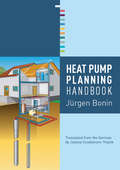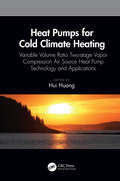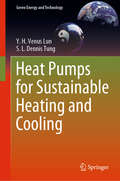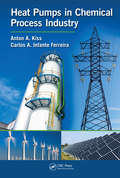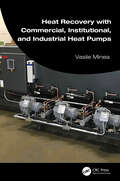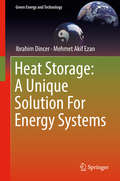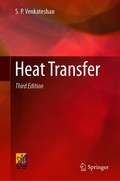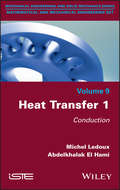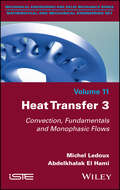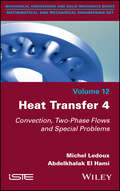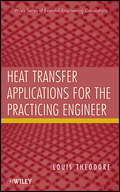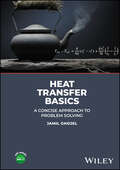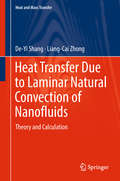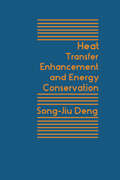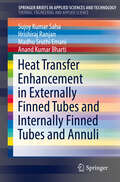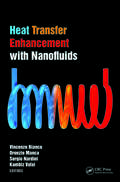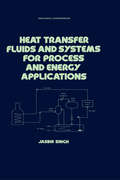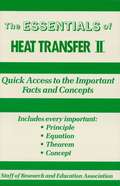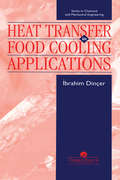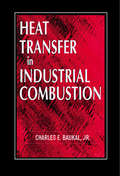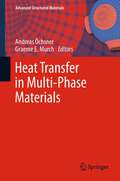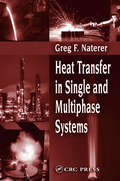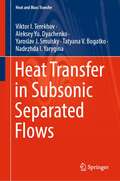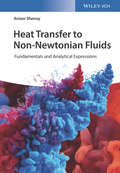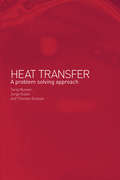- Table View
- List View
Heat Pump Planning Handbook
by Jürgen BoninThe Heat Pump Planning Handbook contains practical information and guidance on the design, planning and selection of heat pump systems, allowing engineers, designers, architects and construction specialists to compare a number of different systems and options. Including detailed descriptions of components and their functions and reflecting the current state of technology this guide contains sample tasks and solutions as well as new model calculations and planning evaluations. Also economic factors and alternative energy sources are covered, which are essential at a time of rising heat costs. Topics included: Ecological and economic aspects Introduction to Refrigeration Water heat pump systems Configuration of all necessary components Planning Examples (Problems and Solutions)
Heat Pumps for Cold Climate Heating: Variable Volume Ratio Two-stage Vapor Compression Air Source Heat Pump Technology and Applications
by Hui HuangAir source heat pumps are mainly used for space heating, and have the advantages of environmental protection, energy saving, and comfort. Written by leading heat pump technology expert Hui Huang, this book summarizes the research and applications of variable volume ratio two-stage vapor compression air source heat pump technology, and its use in cold climate regions. This book can be used for reference by scientific researchers and engineers engaged in research on air source heat pump technology, product development and popularization; and by energy management and policy researchers. It will also be of value to undergraduate and graduate students studying these areas of technology.
Heat Pumps for Sustainable Heating and Cooling (Green Energy and Technology)
by Y. H. Lun S. L. TungThis book highlights the significance of using sustainable energy to prevent the deterioration of our planet using heat pumps. Energy sustainability can be achieved through improved energy efficiency. In this regard, heat pumps offer an energy-efficient alternative for heating and cooling. To drive the adoption of heat pumps as a key component of sustainable buildings, the authors focus on examining sustainable practices in heat pump operations and innovative system design. In view of the growing desire to use sustainable energy to meet heating and cooling demands and improve indoor air quality, this book offers a valuable reference guide to the available options in HVAC (heating, ventilation, and air-conditioning) system design. To begin with, the authors define sustainable energy and discuss the trend of “thinking green” in building design. They then discuss sustainable practices and heat pump applications in mapping out HVAC systems. In turn, they examine the use of green operations to promote sustainable practices and, in order to highlight the importance of innovative design, discuss the configuration options and precision control aspects. In closing, the authors illustrate innovative sustainable design on the basis of several energy-efficient cases. The book’s main goal is to drive the adoption of sustainable energy solutions. Heat pumps, it argues, represent the most efficient system for meeting commercial/recreational/residential heating and cooling demands. The book not only examines industrial practices in heat pump application, but also discusses advanced heat pump technologies and innovative heat pump designs.
Heat Pumps in Chemical Process Industry
by Anton A. Kiss Carlos A. Infante FerreiraAs the chemical process industry is among the most energy demanding sectors, chemical engineers are endeavoring to contribute towards sustainable future. Due to the limitation of fossil fuels, the need for energy independence, as well as the environmental problem of the greenhouse gas effect, there is a large increasing interest in the research and development of chemical processes that require less capital investment and reduced operating costs and lead to high eco-efficiency. The use of heat pumps is a hot topic due to many advantages, such as low energy requirements as well as an increasing number of industrial applications. Therefore, in the current book, authors are focusing on use of heat pumps in the chemical industry, providing an overview of heat pump technology as applied in the chemical process industry, covering both theoretical and practical aspects: working principle, applied thermodynamics, theoretical background, numerical examples and case studies, as well as practical applications. The worked-out examples have been included to instruct students, engineers and process designers about how to design various heat pumps used in the industry. Reader friendly resources namely relevant equations, diagrams, figures and references that reflect the current and upcoming heat pump technologies, will be of great help to all readers from the chemical and petrochemical industry, biorefineries and other related areas.
Heat Recovery with Commercial, Institutional, and Industrial Heat Pumps
by Vasile MineaHeat Recovery with Commercial, Institutional, and Industrial Heat Pumps presents the basic concepts and thermodynamic behavior of mechanical vapor compression and recompression. It covers both ammonia water absorption and compression/resorption heat pumps.Including theoretical and practical approaches, the book features numerous solved exercises based on real thermodynamic and climatic parameters and case studies with takeaways from on-site experiences to help the reader better identify the advantages and limitations of each heat pumping technology. The book discusses future implementations of heat recovery heat pump technologies that are among the most energy-efficient and environmentally friendly techniques.This book will interest graduate students studying HVAC, thermal systems, and heat pumps. It will also benefit professionals working with heat pumps, industrial process engineers, manufacturers, and research and design personnel.
Heat Storage: A Unique Solution For Energy Systems (Green Energy and Technology)
by Ibrahim Dincer Mehmet Akif EzanThis book covers emerging energy storage technologies and material characterization methods along with various systems and applications in building, power generation systems and thermal management. The authors present options available for reducing the net energy consumption for heating/cooling, improving the thermal properties of the phase change materials and optimization methods for heat storage embedded multi-generation systems. An in-depth discussion on the natural convection-driven phase change is included. The book also discusses main energy storage options for thermal management practices in photovoltaics and phase change material applications that aim passive thermal control. This book will appeal to researchers and professionals in the fields of mechanical engineering, chemical engineering, electrical engineering, renewable energy, and thermodynamics. It can also be used as an ancillary text in upper-level undergraduate courses and graduate courses in these fields.
Heat Transfer
by S.P. VenkateshanThe book covers various topics of heat transfer. It explains and analyzes several techniques and modes of heat transfer such as conduction in stationary media, convection in moving media and also by radiation. It is primarily a text book useful for undergraduate and postgraduate students. The book should also interest practicing engineers who wish to refresh their knowledge in the field. The book presents the various topics in a systematic way starting from first principles. The topics are developed to a fairly advanced level towards the end of each chapter. Several worked examples illustrate the engineering applications of the basic modeling tools developed in the text. The exercises at the end of the book are arranged chapter wise and challenge the reader to tackle typical real-life problems in heat transfer. This book will be of potential use for students of mechanical engineering, chemical engineering and metallurgy in most engineering colleges.
Heat Transfer 1: Conduction
by Michel Ledoux Abdelkhalak El HamiHeat is a branch of thermodynamics that occupies a unique position due to its involvement in the field of practice. Being linked to the management, transport and exchange of energy in thermal form, it impacts all aspects of human life and activity. Heat transfers are, by nature, classified as conduction, convection (which inserts conduction into fluid mechanics) and radiation. The importance of these three transfer methods has resulted – justifiably – in a separate volume being afforded to each of them. This first volume is dedicated to thermal conduction, and, importantly, assumes an analytical approach to the problems presented, and recalls the fundamentals. Heat Transfer 1 combines a basic approach with a deeper understanding of the discipline and will therefore appeal to a wide audience, from technician to engineer, from doctoral student to teacher-researcher.
Heat Transfer 3: Convection, Fundamentals and Monophasic Flows
by Michel Ledoux Abdelkhalak El HamiHeat is a branch of thermodynamics that occupies a unique position due to its involvement in the field of practice. Being linked to the management, transport and exchange of energy in thermal form, it impacts all aspects of human life and activity. Heat transfers are, by nature, classified as conduction, convection (which inserts conduction into fluid mechanics) and radiation. The importance of these three transfer methods has resulted – justifiably – in a separate volume being afforded to each of them, with the subject of convection split into two volumes.This third volume is dedicated to convection, more specifically, the foundations of convective transfers. Various angles are considered to cover this topic, including empirical relationships and analytically approaching boundary layers, including the integral methods and numerical approaches. The problem of heat exchangers is presented, without aiming to be an exhaustive treatise. Heat Transfer 3 combines a basic approach with a deeper understanding of the discipline and will therefore appeal to a wide audience, from technician to engineer, from doctoral student to teacher-researcher.
Heat Transfer 4: Convection, Two-Phase Flows and Special Problems
by Abdelkhalak El Hami Michel LedouxHeat Transfer 4: Convection, Two-Phase Flows and Special Problems
Heat Transfer Applications for the Practicing Engineer
by Louis TheodoreThis book serves as a training tool for individuals in industry and academia involved with heat transfer applications. Although the literature is inundated with texts emphasizing theory and theoretical derivations, the goal of this book is to present the subject of heat transfer from a strictly pragmatic point of view. The book is divided into four Parts: Introduction, Principles, Equipment Design Procedures and Applications, and ABET-related Topics. The first Part provides a series of chapters concerned with introductory topics that are required when solving most engineering problems, including those in heat transfer. The second Part of the book is concerned with heat transfer principles. Topics that receive treatment include Steady-state Heat Conduction, Unsteady-state Heat Conduction, Forced Convection, Free Convection, Radiation, Boiling and Condensation, and Cryogenics. Part three (considered the heart of the book) addresses heat transfer equipment design procedures and applications. In addition to providing a detailed treatment of the various types of heat exchangers, this part also examines the impact of entropy calculations on exchanger design, and operation, maintenance and inspection (OM&I), plus refractory and insulation effects. The concluding Part of the text examines ABET (Accreditation Board for Engineering and Technology) related topics of concern, including economies and finance, numerical methods, open-ended problems, ethics, environmental management, and safety and accident management.
Heat Transfer Basics: A Concise Approach to Problem Solving
by Jamil GhojelHEAT TRANSFER BASICS Concise introduction to heat transfer, with a focus on worked example problems to aid in reader comprehension and student learning Heat Transfer Basics covers the essential topics of heat transfer in a focused manner, starting with an introduction to heat transfer that explains its relationship to thermodynamics and fluid mechanics and continuing on to key topics such as free convection, boiling and condensation, radiation, heat exchangers, and more, for an accessible and reader-friendly yet comprehensive treatment of the subject. Each chapter features multiple worked out example problems, including derivations of key governing equations and comparisons of worked solutions with computer modeled results, which helps students become familiar with the types of problems they will encounter in the field. Throughout the book, figures and diagrams liberally illustrate the concepts discussed, and practice problems allow students to test their understanding of the content. The text is accompanied by an online instructor’s manual. Heat Transfer Basics includes information on: One-dimensional, steady-state conduction, covering the plane wall, the composite wall, solid and hollow cylinders and sphere, conduction with and without internal energy generation, and conduction with constant and temperature-dependent thermal conductivity Heat transfer from extended surfaces, fins of uniform and variable cross-sectional area, fin performance, and overall fin efficiency Transient conduction, covering general lumped capacitance solution method, one- and multi-dimensional transient conduction, and the finite-difference method for solving transient problems Free and forced convection, covering hydrodynamic and thermal considerations, the energy balance, and thermal analysis and convection correlations More advanced than introductory textbooks yet not as overwhelming as textbooks targeted at specialists, Heat Transfer Basics is ideal for students in introductory and advanced heat transfer courses who do not intend to specialize in heat transfer, and is a helpful reference for advanced students and practicing engineers.
Heat Transfer Due to Laminar Natural Convection of Nanofluids: Theory And Calculation (Heat And Mass Transfer Ser.)
by De-Yi Shang Liang-Cai ZhongThis book presents a theoretical study of heat transfer due to laminar natural convection of nanofluids, using Al2O3-water nanofluid as an example. An innovative method of similarity transformation of velocity fields on laminar boundary layers is applied for the development of a mathematical governing model of natural convection with actual nanofluids, and a novel model of the nanofluid's variable thermophysical properties is derived by a mathematical analysis based on the developed model of variable physical properties of fluids combined with the model of the nanofluid's thermal conductivity and viscosity. Based on these, the physical property factors of nanofluids are produced, which leads to a simultaneous solution for deep investigations of hydrodynamics and heat transfer of nanofluid's natural convection.The book also proposes novel predictive formulae for the evaluation of heat transfer of Al2O3-water nanofluid’s natural convection. The formulae have reliable theoretical and practical value because they are developed by rigorous theoretical analysis of heat transfer combined with full consideration of the effects of the temperature-dependent physical properties of nanofluids and the nanoparticle shape factor and concentration, as well as variations of fluid boundary temperatures. The conversion factors proposed help to turn the heat transfer coefficient and rate of fluid natural convection into those of nanofluid natural convection. Furthermore, several calculation examples are provided to demonstrate the heat transfer application of the proposed predictive formulae.
Heat Transfer Enhancement And Energy Conservation
by Songshjiu DengHeat transfer is close connected to the better utilization of thermal energy. This book provides an international perspective on the status of heat transfer enhancement and energy conservation research, development, and applications. It contains scientific papers from countries and areas including Bahrain, Canada, China, France, the Federal Republic of Germany, Hong Kong, Italy, India, Japan, New Zealand, Poland, the United Kingdom, the United States of America, and Yugoslavia. It is a valuable reference for anyone interested in heat transfer enhancement and energy conservation.
Heat Transfer Enhancement in Externally Finned Tubes and Internally Finned Tubes and Annuli (SpringerBriefs in Applied Sciences and Technology)
by Sujoy Kumar Saha Hrishiraj Ranjan Madhu Sruthi Emani Anand Kumar BhartiThis Brief deals with externally finned tubes, their geometric parameters, Reynolds number, dimensionless variables, friction factor, plain plate fins on round tubes, the effect of fin spacing, correlations, pain individually finned tubes, circular fins with staggered tubes, low integral fin tubes, wavy fin, enhanced plate fin geometries with round tubes, Offset Strip Fins, convex louver fins, louvered fin, perforated fin, mesh fin, vortex generator, enhanced circular fin geometries, spine or segmented fin, wire loop fin, flat extruded tubes with internal membranes, plate and fin automotive radiators, performance comparison, numerical simulation, advanced fin geometries, hydrophilic coatings, internally finned tubes and annuli, spirally fluted and indented tube, advanced internal fin geometries, and finned annuli. The book is ideal for professionals and researchers dealing with thermal management in devices.
Heat Transfer Enhancement with Nanofluids
by Oronzio Manca Kambiz Vafai Vincenzo Bianco Sergio NardiniNanofluids are gaining the attention of scientists and researchers around the world. This new category of heat transfer medium improves the thermal conductivity of fluid by suspending small solid particles within it and offers the possibility of increased heat transfer in a variety of applications. Bringing together expert contributions from
Heat Transfer Fluids and Systems for Process and Energy Applications
by Jasbir SinghThis book presents the basic principles and engineering data governing the process design of indirect heat transfer fluids and systems. It focuses on the selection of systems based on common engineering criteria such as reliability and cost, and particularly on energy conservation and safety.
Heat Transfer II Essentials
by The Editors of REAREA's Essentials provide quick and easy access to critical information in a variety of different fields, ranging from the most basic to the most advanced. As its name implies, these concise, comprehensive study guides summarize the essentials of the field covered. Essentials are helpful when preparing for exams, doing homework and will remain a lasting reference source for students, teachers, and professionals. Heat Transfer II reviews correlations for forced convection, free convection, heat exchangers, radiation heat transfer, and boiling and condensation.
Heat Transfer In Food Cooling Applications
by Ibrahim DincerThis comprehensive book is a valuable and readable reference text and source for anyone who wishes to learn about food cooling applications and methods of analysis of the heat transfer during these applications.
Heat Transfer in Industrial Combustion
by Charles E. Baukal Jr.Industry relies heavily on the combustion process. The already high demand for energy, primarily from combustion, is expected to continue to rapidly increase. Yet, the information is scattered and incomplete, with very little attention paid to the overall combustion system. Designed for practicing engineers, Heat Transfer in Industrial Combustion e
Heat Transfer in Multi-Phase Materials
by Andreas Öchsner Graeme E. MurchThis book provides a profound understanding, which physical processes and mechanisms cause the heat transfer in composite and cellular materials. It shows models for all important classes of composite materials and introduces into the latest advances. In three parts, the book covers Composite Materials (Part A), Porous and Cellular Materials (Part B) and the appearance of a conjoint solid phase and fluid aggregate (Part C).
Heat Transfer in Single and Multiphase Systems
by Greg F. NatererExtensively revised and thoroughly updated, this popular text de-emphasizes high level mathematics in favor of effective, accurate modeling. Real-world examples amplify the theory and show how to use derived equations to model physical problems. Exercises that parallel the examples build readers' confidence and prepare them to confront the more com
Heat Transfer in Subsonic Separated Flows (Heat and Mass Transfer)
by Viktor I. Terekhov Aleksey Yu. Dyachenko Yaroslav J. Smulsky Tatyana V. Bogatko Nadezhda I. YaryginaThis book presents the results of scientific research performed over the past two decades by the authors. The book discusses some issues of separated laminar flows that are of great practical interest for the development of new technologies using microchannel flows, where separation zones can form. Of particular interest is the complex mechanism of flow separation with superimposed high external turbulence. The challenges of finding the optimal location for the cavities and fins on heat exchange surfaces are also considered. This is an important fundamental and practical problem when creating new schemes of efficient heat exchangers in various power plants. A wide class of problems of turbulent flow in tubes with flow separation is considered. These data will be useful in engineering estimates of the thermal–hydraulic efficiency of various heat transfer intensifiers. This book focuses on the analysis of thermal characteristics of separated flows, as well as the possibility of controlling the intensity of heat exchange processes, from the point of view of both their intensification and their suppression.
Heat Transfer to Non-Newtonian Fluids: Fundamentals and Analytical Expressions
by Aroon ShenoyThis book has been written with the idea of providing the fundamentals for those who are interested in the field of heat transfer to non-Newtonian uids. It is well recognized that non-Newtonian fluids are encountered in a number of transport processes and estimation of the heat transfer characteristics in the presence of these fl uids requires analysis of equations that are far more complex than those encountered for Newtonian fl uids. A deliberate effort has be made to demonstrate the methods of simplication of the complex equations and to put forth analytical expressions for the various heat transfer situations in as vivid manner as possible. The book covers a broad range of topics from forced, naturaland mixed convection without and with porous media. Laminaras well as turbulent flow heat transfer to non-Newtonian fluids have been treated and the criterion for transition from laminar toturbulent fl ow for natural convection has been established. The heat transfer characteristics of non-Newtonian fl uids from inelastic power-law fluids to viscoelastic second-order fluids and mildly elastic drag reducing fl uids are covered. This book can serve the needs of undergraduates, graduates and industry personnel from the fields of chemical engineering, material science and engineering, mechanical engineering and polymer engineering.
Heat Transfer: A Problem Solving Approach
by Tariq Muneer Kubie Jorge Grassie ThomasA core task of engineers is to analyse energy related problems. The analytical treatment is usually based on principles of thermodynamics, fluid mechanics and heat transfer, but is increasingly being handled computationally.This unique resource presents a practical textbook, written for both undergraduates and professionals, with a series of over 60 computer workbooks on an accompanying CD.The book emphasizes how complex problems can be deconstructed into a series of simple steps. All thermophysical property computations are illustrated using diagrams within text and on the companion CD.
